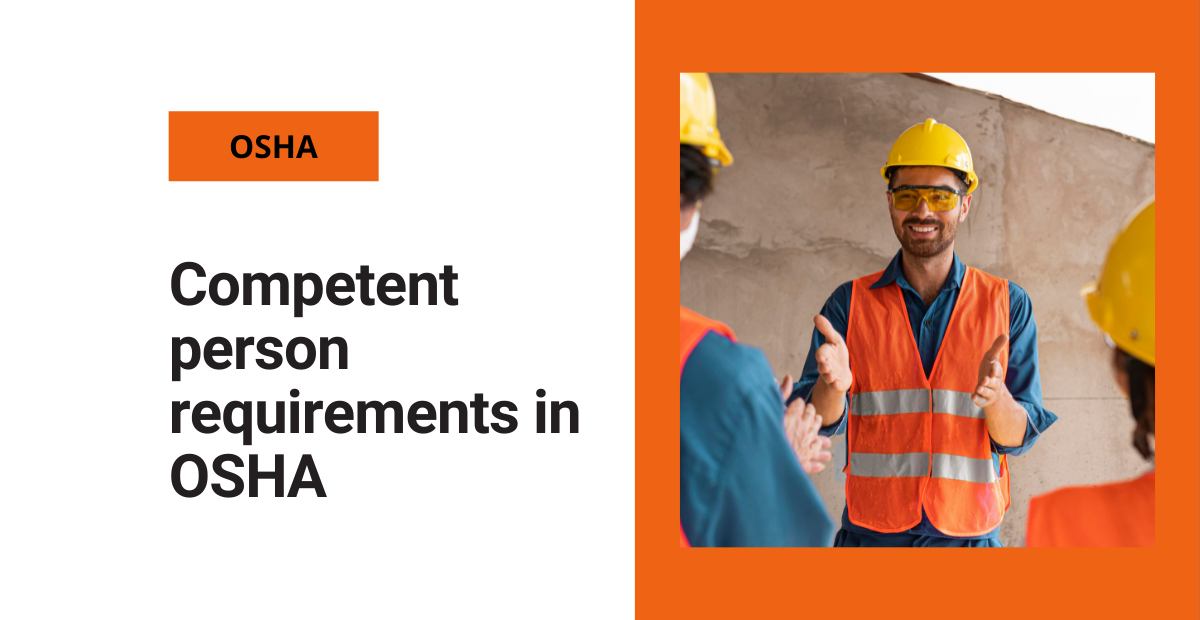Understanding OSHA’s competent person requirements starts by understanding the difference between competent and qualified individuals.
This guide outlines the difference between these terms and provides an understanding of which OSHA General Industry regulations require a competemnt person to perform specific tasks to ensure compliance.
Competent person requirements key definitions
According to 29 CFR 1926.32 General Safety and Health Provisions:
A “Competent Person” means one who is capable of identifying existing and predictable hazards in the surroundings or working conditions that are unsanitary, hazardous, or dangerous to employees and who has the authorization to take prompt corrective measures to eliminate them.
In laymen’s terms, by way of training and/or experience, a competent person is knowledgeable of applicable standards, is capable of identifying workplace hazards relating to the specific operation, and has the authority to correct them. Some standards add additional specific requirements that the competent person must meet.
A “Qualified person” means one who, by the possession of a recognized degree, certificate, or professional standing, or who by extensive knowledge, training, and experience, has successfully demonstrated his ability to solve or resolve problems relating to the subject matter, the work, or the project.
To summarize, a qualified person is someone that has the education or experience to help solve problems.
Documents for competent person requirements
Everyone in your workplace is responsible for working towards EHS excellence. It is a good idea to provide designated workers with specific training that will allow them to assume a leadership role in EHS programs.
Many OSHA standards and documents required a competent person, including:
- General Industry (29 CFR 1910)
- Construction (29 CFR 1926)
- Maritime (29 CFR 1915, 1917, 1918)
- Gear Certification (29 CFR 1919)
- State OSHA Plans
- Preambles to Final Rules
- Additional Letters Of Interpretation
OSHA regulations with competent person requirements
This guide focuses on OSHA General Industry Regulations requiring a Competent Person. The information below summarizes the Subpart, Standard Number, Title, and Competent Person requirements under that Subpart.
Subpart: 1910 Subpart F - Powered Platforms, Manlifts, and Vehicle-Mounted Work Platforms
Standard Number and Title: 1910.66, Powered platforms for building maintenance.
1910.66 definition of a competent person
A competent person means a person who, because of training and experience, is capable of identifying hazardous or dangerous conditions in powered platform installations and of training employees to identify such conditions.
Periodic inspections and tests
Related building supporting structures shall undergo periodic inspection by a competent person at intervals not exceeding 12 months.
All parts of the equipment shall be inspected and, where necessary, tested by a competent person at intervals specified by the manufacturer, but not to exceed 12 months.
Maintenance inspections and tests
A maintenance inspection and a test shall be made of each platform installation every 30 days, or where the work cycle is less than 30 days, such inspection and/or test shall be made before each work cycle. This inspection and test shall follow procedures recommended by the manufacturer and shall be made by a competent person.
Frontline ACT for equipment maintenance
Use our action tracking software to coordinate all maintenance tasks for inspections, repairs, and more.
Special inspection of governors and secondary brakes
A competent person shall perform an inspection of governors and secondary brakes.
Suspension wire rope maintenance, inspection, and replacement
A competent person shall inspect suspension wire rope for visible defects and gross damage to the rope before every use and after each occurrence, which might affect the wire rope’s integrity.
Competent person training requirements
A competent person shall train employees in the operation and inspection of working platforms.
Subpart: 1910 Subpart H – Hazardous Materials
Standard Number and Title: 1910.109, Explosives, and blasting agents.
Storage within magazines
A competent person shall be in charge of magazines at all times and be responsible for the enforcement of all safety precautions.
Explosives recovered from blasting misfires should remain in a separate magazine until competent personnel determines the best disposal method.
Transportation vehicles
Extinguishers should be ready for immediate use and located near the driver’s seat. They should also undergo periodic inspections by a competent person.
Subpart: 1910 Subpart N - Materials Handling and Storage
Standard Number and Title: 1910.183, Helicopters
Cargo hooks
The employer shall ensure that the hooks are tested before each day’s operation by a competent person to determine that the release functions correctly, both electrically and mechanically.
Standard Number and Title: 1910.184, Slings
Inspections
Each day before use, the sling, fastenings, and attachments shall be inspected for damage or defects by a competent person designated by the employer.
Subpart: 1910 Subpart R – Special Industries
Standard Number and Title: 1910.268, Telecommunications.
Support structures
No employee, or any material or equipment, should be supported on any portion of a pole structure, platform, ladder, walkway, or other elevated structure or aerial device unless the employer ensures that a competent person first inspects the support structure. It must be determined to be adequately strong, in good working condition, and adequately secured in place.
Tools and personal protective equipment
Before each day’s use, the employer shall ensure that a competent person carefully inspects these personal protective devices, tools, and equipment to ascertain that they are in good condition.
Pole climbers
The employer shall ensure that a competent person inspects pole climbers for the following conditions: Fractured or cracked gaffs or leg irons, loose or dull gaffs, broken straps, or buckles. If any of these conditions exist, you need to fix the defect before using the pole climbers.
General requirements
Employers should ensure that a competent person performs visual inspections of the equipment. These inspections should take place on a daily basis.
At the start of every shift, a competent person should ensure that the vehicle brakes and operating systems are in proper working condition.
Derrick trucks and similar equipment
The employer shall ensure that a competent person inspects the derrick and its associated equipment at intervals set by the manufacturer but in no case less than once per year.




